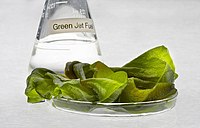
Photo from wikipedia
Abstract Biodiesel production from microalgae is viable but faces scale-up challenges. The main drawbacks in the industrial production of biodiesel are high-water content in the biomass (~80%) and the numbers… Click to show full abstract
Abstract Biodiesel production from microalgae is viable but faces scale-up challenges. The main drawbacks in the industrial production of biodiesel are high-water content in the biomass (~80%) and the numbers of process stages involved in its production. Using direct transesterification is taken into account to be a good solution; because lipid-extraction and transesterification processes are completed in one step. This converts wet biomass directly into biodiesel. This study evaluates a single-step, environmentally-friendly method that directly converts wet microalgae into biodiesel directly with the involvement of supercritical carbon dioxide. Carbon dioxide is exploited in a supercritical state to simultaneously extract lipids from algal biomass impregnated with 15 cc ethanol per 1 g dry microalgal and transesterify that extract to generate fatty-acid-ethyl esters. Wet microalgal biomass of Nannochloropsis oculata was used as the biomass feed for this process. Its biodiesel production efficiency is impacted by temperature and water content. Water has a negative effect on productivity at temperatures
Journal Title: Fuel
Year Published: 2021
Link to full text (if available)
Share on Social Media: Sign Up to like & get
recommendations!